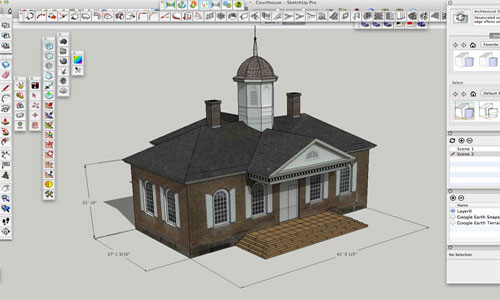SketchUp Inferences in SketchUp make you understand where you
design your model. The color lines will appear as soon as you create a new file
in SketchUp. These lines are the best to keep your model at the right place you
want. It is always advisable to use the color lines while working on the
SketchUp as they eliminate the need for typing commands for adjusting the
position of the model. You need to work in the intended color direction, and
you must align your object with the drawing axes of SketchUp.
Inferences: When you design 3D models in SketchUp, many features
appear in the form of color squares, dotted lines, yellow tags, and other
objects of this kind. These features are called together as SketchUp inference
engine. To design a model accurately and quickly, you have to understand each
feature elaborately and its usage.
Point Inferences: Point inferences tell you about different
things of your design, they guide you how to add or change details of the
models. If you move the cursor on the working window of the SketchUp, you will
definitely be introduced with different colored shapes. If you stay on those
shapes for a second, a yellow tag will appear explaining the definition of the
color spot you put the cursor on. Here is the list of various point inferences
and their meaning.
• Green – endpoint
• Cyan or light blue – midpoint
• Black – intersection
• Red – on edge
• A circle, green – centre
• Dark Blue – on face
• Cyan or light blue – midpoint
• Black – intersection
• Red – on edge
• A circle, green – centre
• Dark Blue – on face
In SketchUp, two basic elements that everyone should know about
are – edges (lines) and faces (surfaces). To design efficiently on the
SketchUp, you have a comprehensive idea about these two features first.
Linear Inference: Colors definitely play a very important role
in your designing in the SketchUp. Linear inferences also help a designer draw
a 3D model precisely and perfectly. These linear inferences are also called
‘help lines’ as they play a big role defining your object. Below are the descriptions
of the work of linear inferences.
• On Axis – If the edge you draw is parallel to
one of the three drawing axes of SketchUp, the edge takes the color of that
particular drawing axe.
• From Point – When you are moving a cursor in the SketchUp, a colored, dotted line appear that tells you are lined up with the end point of the dotted line. The color of the From Point will automatically change as per the color of the axes it corresponds with.
• Perpendicular – the edge you are drawing must be perpendicular to another edge of the design. Your drawn edge will be colored in magenta.
• Parallel – If the edge you are sketching becomes parallel to another edge of your model, the drawn edge turns into magenta.
• Tangent at Vertex – this idea comes into the application when you are drawing an arc that starts at the end point of another arc. When your drawn arc is the tangent of another arc, it turns into cyan.
• From Point – When you are moving a cursor in the SketchUp, a colored, dotted line appear that tells you are lined up with the end point of the dotted line. The color of the From Point will automatically change as per the color of the axes it corresponds with.
• Perpendicular – the edge you are drawing must be perpendicular to another edge of the design. Your drawn edge will be colored in magenta.
• Parallel – If the edge you are sketching becomes parallel to another edge of your model, the drawn edge turns into magenta.
• Tangent at Vertex – this idea comes into the application when you are drawing an arc that starts at the end point of another arc. When your drawn arc is the tangent of another arc, it turns into cyan.
SketchUp inferences engine defines the basics
of the 3D designing, without which your object does not take the expected form.
The use of these applications is more than the usual.

~~~~~~~~~~~~~~~~~~~~~~~~~~
Published By
Rajib Dey
www.sketchup4architect.com
~~~~~~~~~~~~~~~~~~~~~~~~~~
No comments:
Post a Comment